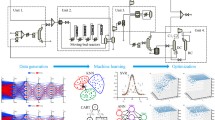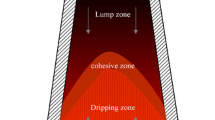Abstract
As a highly complex multi-input and multi-output system, blast furnace plays an important role in industrial development. Although much research has been done in the past few decades, there still exist many problems to be solved, such as the modeling problem. This paper adopts support vector regression (SVR) to construct the prediction model of blast furnace silicon content. To ensure a good generalization performance for the given datasets, it is important to select proper parameters for SVR. In view of this problem, a new particle swarm optimizer called DMS-PSO-CLS is presented to optimize the parameters of SVR. In DMS-PSO-CLS, a new cooperative learning strategy is hybridized with DMS-PSO, which makes particle information be used more effectively for generating better-quality solutions. DMS-PSO-CLS takes merits of the DMS-PSO and the cooperative learning strategy so that both the convergence speed and the convergence precision can be improved. Experimental results show that DMS-PSO-CLS can find the optimal parameters of SVR with high speed and the SVR model optimized by DMS-PSO-CLS can achieve a good regression precision on the predictive problem of blast furnace.










Similar content being viewed by others
Explore related subjects
Discover the latest articles, news and stories from top researchers in related subjects.References
Gao CH, Jian L, Liu XY, Chen JM, Sun YX (2011) Data-driven modeling based on volterra series for multidimensional blast furnace system. IEEE Trans Neural Netw 22(12):2272–2283
Jian L, Gao CH (2013) Binary coding SVMs for the multiclass problem of the blast furnace system. IEEE Trans Ind Electron 60(9):3846–3856
Gao CH, Ling J, Luo SH (2012) Modeling of the thermal state change of blast furnace heart with support vector machines. IEEE Trans Ind Electron 59(2):1134–1145
Radhakrishnan VR, Mohamed AR (2000) Neural networks for the identification and control of blast furnace hot metal quality. J Process Control 10:509–524
Chen J (2001) A predictive system for blast furnaces by integrating a neural network with qualitative analysis. Eng Appl Artif Intell 14:77–85
Saxén H, Pettersson F (2007) Nonlinear prediction of the hot metal silicon content in the blast furnace. ISIJ Int 47:1732–1737
Martín RD, Obeso F, Mochón J, Barea R, Jiménez J (2007) Hot metal temperature prediction in blast furnace using advanced model based on fuzzy logic tools. Ironmak steelmak 34:241–247
Tang XL, Zhang L, Jian CJ (2009) Prediction of silicon content in hot metal using support vector regression based on chaos particle swarm optimization. Expert Syst Appl 36:11835–11857
Jian L, Gao CH, Xia ZQ (2011) A sliding-window smooth support vector regression model for nonlinear blast furnace system. Steel Res Int 82:169–179
Phadke MS, Wu SM (1974) Identification of multiinput–multioutput transfer function and noise model of a blast furnace from closed-loop data. IEEE Trans Autom Control AC–19(6):944–951
Saxén H, Östermark R (1996) State realization with exogenous variables—a test on blast furnace data. Eur J Oper Res 89:34–52
Bhattacharya T (2005) Prediction of silicon content in blast furnace hot metal using partial least squares (PLS). ISIJ Int 45:1943–1945
Pettersson F, Chakraborti N, Saxén H (2007) A genetic algorithms based multi-objective neural net applied to noisy blast furnace data. Appl Soft Comput 7:387–397
Pettersson F, Saxén H, Deb K (2009) Genetic algorithm-based multi-criteria optimization of ironmaking in the blast furnace. Mater Manuf Process 24:343–349
Saxén H, Gao CH, Gao ZW (2012) Data-driven time discrete models for dynamic prediction of the hot metal silicon content in the blast furnace. IEEE Trans Ind Inform 9(4):2213–2225
Zhao YP, Sun JG (2011) Multikernel semiparametric linear programming support vector regression. Expert Syst Appl 38:1611–1618
Musicant DR, Alexander F (2004) Active set support vector regression. IEEE Trans Neural Netw 15(2):268–275
Tian J, Gu H (2010) Anomaly detection combining one-class SVMs and particle swarm optimization algorithms. Nonlinear Dyn 61(1–2):303–310
Mao WT, Mu XX, Zheng YB, Yan GR (2014) Leave-one-out cross-validation-based model selection for multi-input multi-output support vector machine. Neural Comput Appl 24(2):441–451
Zhao MY, Ren J, Ji LP, Fu C, Li JP, Zhou MT (2012) Parameter selection of support vector machines and genetic algorithm based on change area search. Neural Comput Appl 21(1):1–8
Tian J, Gu H, Gao CY, Lian J (2010) Local density one-class support vector machines for anomaly detection. Nonlinear Dyn 64(1–2):127–130
Deng NY, Tian YJ (2004) New method of data mining-support vector machine. Science Press, Beijing
Kwok JT (2001) Linear dependency between e and the input noise in ε-support vector regression. In: Proceedings of international conference on artificial neural networks, pp. 405–410
Eberhart RC, Kennedy J (1995) A new optimizer using particle swarm theory. In: Proceedings of the sixth international symposium on micro machine and human science, pp. 39–43
Ratanavilisagul C, Kruatrachue AB (2014) A modified particle swarm optimization with mutation and reposition. Int J Innov Comput Inform Control 10(6):2127–2142
Dhanraj AV, Nanjundappan D (2014) Design of optimized PI controller with ideal decoupler for a non linear multivariable system using particle swarm optimization technique. Int J Innov Comput Inform Control 10(1):341–355
Zhang JZ, Ding XM (2011) A multi-swarm self-adaptive and cooperative particle swarm optimization. Eng Appl Artif Intell 24:958–967
Niu B, Zhu YL, He XX, Wu H (2007) MCPSO: a multi-swarm cooperative particle swarm optimizer. Appl Math Comput 185:1050–1062
Zhao SZ, Liang JJ, Suganthan PN, Tasgetiren MF (2008) Dynamic multi-swarm particle swarm optimizer with local search for large scale global optimization. In: Proceedings of the IEEE congress on evolutionary computation, pp. 3845–3852
Liang JJ, Suganthan PN (2005) Dynamic multi-swarm particle swarm optimizer. In: Proceedings of the IEEE congress on swarm intelligence symposium, pp. 124–129
Zeng JS, Gao CH, Su HY (2010) Data-driven predictive control for blast furnace ironmaking process. Comput Chem Eng 34:1854–1862
Fletcher R (1987) Practical methods of optimization, 2nd edn. Wiley, New York
Shi Y, Eberhart RC (1998) A modified particle swarm optimizer. In: Proceedings of the IEEE world congress on evolutionary computational intelligence, pp. 69–73
Eberhart RC, Shi Y (2000) Comparing inertia weights and constriction factors in particle swarm optimization. In: Proceedings of the IEEE congress on evolutionary computation, pp. 84–88
Zhao J, Wang W, Liu Y, Pedrycz W (2011) A two-stage online prediction method for a blast furnace gas system and its application. IEEE Trans Control Syst Technol 19(3):507–520
Acknowledgments
This work is supported in part by the National Natural Science Foundation of China (No. 61273260), the Specialized Research Fund for the Doctoral Program of Higher Education of China (No. 20121333120010), Natural Scientific Research Foundation of the Higher Education Institutions of Hebei Province (No. 2010165), the Major Program of the National Natural Science Foundation of China (No. 61290322) and Foundation of Key Laboratory of System Control and Information Processing, Ministry of Education, P.R. China (No. SCIP2012008).
Author information
Authors and Affiliations
Corresponding author
Rights and permissions
About this article
Cite this article
Xu, X., Hua, C., Tang, Y. et al. Modeling of the hot metal silicon content in blast furnace using support vector machine optimized by an improved particle swarm optimizer. Neural Comput & Applic 27, 1451–1461 (2016). https://doi.org/10.1007/s00521-015-1951-7
Received:
Accepted:
Published:
Issue Date:
DOI: https://doi.org/10.1007/s00521-015-1951-7




